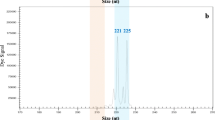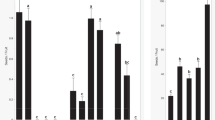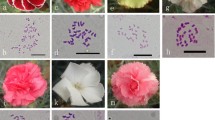Abstract
Numerically unreduced (2n) gametes from first division restitution (FDR) are considered to be superior to 2n-gametes from second division restitution (SDR) because they transfer a larger proportion of the total parental heterozygosity and epistasis intact to the tetraploid progeny. This supposed superiority was investigated by comparing 12 sets of reciprocal 4x-2x crosses. Each diploid parent used in a reciprocal set produced 2n-pollen by FDR and 2n-eggs by SDR. Six agronomic characters were investigated. FDR progenies (from 4x.2x) were found to have higher mean yields due to more and bigger tubers. With respect to underwater weight, the overall progeny mean of FDR progenies was significantly higher than that of SDR progenies (from 2x.4x). However, the absolute difference found between both overall progeny means was too small to be of practical significance. No differences between FDR and SDR progeny means were found for vine maturity and chip colour. In addition to the progeny mean, within-progeny variation is important in potato breeding. For vine maturity a higher within-progeny variation was detected in SDR progenies, whereas within-progeny variations for yield, underwater weight and chip colour were not different in FDR and SDR progenies. With regard to vine maturity, we conclude that SDR 2n-gametes are superior to FDR 2n-gametes because, with the same progeny means of FDR and SDR progenies, the within-progeny variation was higher in SDR progenies. Therefore the assumed superiority of FDR 2n-gametes was confirmed for yield but was not observed for vine maturity, underwater weight and chip colour.
Similar content being viewed by others
References
Chase SS (1963) Analytic breeding in Solanum tuberosum L. — A scheme utilizing parthenotes and other diploid stocks. Can J Genet Cytol 5: 359–363
Douches DS, Quiros CF (1988a) Genetic recombination in a diploid synaptic mutant and a Solatium tuberosum x S. chacoense diploid hybrid. Heredity 60: 183–191
Douches DS, Quiros CF (1988b) Genetic strategies to determine the mode of 2n egg formation in diploid potatoes. Euphytica 38:247–260
Engel KH (1956) Untersuchungen an reziproken Kreuzungs-populationen von Kulturkartoffeln. Züchter 26: 33–36
Hermsen JGTh (1984) Mechanisms and genetic implications of 2n-gamete formation. Iowa State J Res 58: 421–434
Hermsen JGTh, Jongedijk E, Ramanna MS (1987) An evaluation of new methods and techniques for potato breeding. In: Fold NE, Hansen SE, Nielsen NK, Rasmussen R (eds) Proc 10th Triennial Conf EAPR. Aalborg, Denmark, pp 30–42
Hoopes RW, Plaisted RL, Cubillos AG (1980) Yield and fertility of reciprocal-cross Tuberosum-Andigena hybrids. Am Potato J 57: 275–284
Jongedijk E (1985) The pattern of megasporogenesis and megagametogenesis in diploid Solanum species hybrids; its relevance to the origin of 2n-eggs and the induction of apomixis. Euphytica 34: 599–611
Jongedijk E, Ramanna MS (1988) Synaptic mutants in potato, Solanum tuberosum L. I. Expression and identity of genes for desynapsis. Genome 30: 664–670
Jongedijk E, Ramanna MS (1989) Synaptic mutants in potato, Solanum tuberosum L. II. Concurrent reduction of chiasma frequencies in male and female meiosis of ds-1 (desynapsis) mutants. Genome 32: 1054–1062
Jongedijk E, Hutten RGB, Wolk van der MASA, Schuurmans, Stekhoven SIJ (1991a) Synaptic mutants in potato, Solanum tuberosum L. III. Effect of the DS-1/ds-1 locus (desynapsis) on genetic recombination in male and female meiosis. Genome 34: 121–130
Jongedijk E, Ramanna MS, Sawor Z, Hermsen JGTh (1991b) Formation of first division restitution (FDR) 2n-megaspores through pseudohomotypic division in ds-1 (desynapsis) mutants of diploid potato: routine production of tetraploid progeny from 2xFDR x 2xFDR crosses. Theor Appl Genet 82: 645–656
Kidane-Mariam H-M, Peloquin SJ (1974) The effect of direction of hybridization (4x × 2x vs. 2x × 4x) on yield of cultivated potatoes. Am Potato J 51: 330–336
Kidane-Mariam H-M, Peloquin SJ (1975) Method of diplandroid formation and yield of progeny from reciprocal (4x-2x) crosses. J Am Soc Hortic Sci 100: 602–603
Maris B (1989) Analysis of an incomplete diallel cross among three ssp. tuberosum varieties and seven long-day adapted ssp. andigena clones of the potato (S. tuberosum L.). Euphytica 41: 163–182
Marks GE (1966) The origin and significance of intraspecific polyploidy: experimental evidence from Solanum chacoense. Evolution 20: 552–557
Mendiburu AO, Peloquin SJ (1977) The significance of 2n gametes in potato breeding. Theor Appl Genet 49: 53–61
Mendiburu AO, Peloquin SJ (1979) Gene-centromere mapping by 4x-2x matings in potatoes. Theor Appl Genet 54:177–180
Mok DWS, Peloquin SJ (1975) Breeding value of 2n-pollen (diplandroids) in tetraploid x diploid crosses in potatoes. Theor Appl Genet 46: 307–314
Ramanna MS (1979) A re-examination of the mechanisms of 2n gamete formation in potato and its implications for breeding. Euphytica 28: 537–561
Sanford JC, Hanneman RE Jr (1982) Large yield differences between reciprocal families of Solanum tuberosum. Euphytica 31: 1–12
Staub JE, Grun P, Amoah V (1982) Cytoplasmic evaluations during substitution backcrossing in Solanum. Potato Res 25: 299–319
Stelly DM, Peloquin SJ (1986) Diploid female gametophyte formation in 24-chromosome potatoes: genetic evidence for the prevalence of the second meiotic division restitution mode. Can J Genet Cytol 28: 101–108
Tarn TR, Tai GCC (1977) Heterosis and variation of yield components in f1 hybrids between Group Tuberosum and Group Andigena potatoes. Crop Sci 17: 517–521
Watanabe K, Peloquin SJ (1993) Cytological basis of 2n pollen formation in a wide range of 2x, 4x and 6x taxa from tuber-bearing Solanum species. Genome 36: 8–13
Werner JE, Peloquin SJ (1987) Frequency and mechanisms of 2n egg formation in haploid tuberosum-wild species F1 hybrids. Am Potato J 64: 641–654
Werner JE, Peloquin SJ (1991) Occurrence and mechanisms of 2n egg formation in 2x potato. Genome 34: 975–982
Author information
Authors and Affiliations
Additional information
Communicated by G. Wenzel
Rights and permissions
About this article
Cite this article
Hutten, R.C.B., Schippers, M.G.M., Hermsen, J.G.T. et al. Comparative performance of FDR and SDR progenies from reciprocal 4x-2x crosses in potato. Theoret. Appl. Genetics 89, 545–550 (1994). https://doi.org/10.1007/BF00222446
Received:
Accepted:
Issue Date:
DOI: https://doi.org/10.1007/BF00222446




